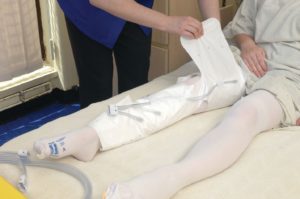Recovery from surgery is easier now that we have anti-embolism socks. Anti-embolism stockings are essentially a subset of compression socks, commonly used for patients restricted to bed and awaiting recovery. In this article, we will review what an anti-embolism sock is all about, how it works and reasons for wearing them. Relax and read on!
Embolism: What does it mean?
Venous thromboembolism (VTE) is a complication involving deep vein thrombosis (DVT) and pulmonary embolism. DVT arises from the accumulation of blood in a deep vein— normally in the lower limb, pelvis or thigh — while pulmonary embolism (PE) arises when a blood clot bursts and moves through through bloodstream into the lung .
There is a great risk of patients developing either deep vein thrombosis (DVT) or pulmonary embolism after surgery or injury. This occurrence necessitates the recommendation and use of anti-embolism stockings for patients recovering from surgery or an injury.
What are anti-embolism stockings?

As we discussed earlier, anti-embolism stockings work the same way as compression socks. They are designed with compact fabrics that boost the flow of blood, thus inhibiting blood clot formation. Also, compression socks are designed with varying levels of compression between 5 mmHg to 60 mmHg while anti-embolism socks have their highest compression level at 18 mmHg. The reason for its relatively low compression level is to maintain adequate venous response in patients without needing to address already present venous issues.
While the terms “graduated compression hosiery” and “anti-embolism stockings” are often used interchangeably, anti-embolism stockings is quite specific and limited in use. Only patients required to spend long hours in bed are prescribed anti-embolism stockings to wear.
How does an anti-embolism stocking work?

You need to have a thorough understanding of the entire circulatory system to know how anti-embolism stockings work. Blood pumped by your heart moves through the circulatory system carrying oxygenated blood and nutrients to tissues, organs, and body cells throughout your body. The blood then flows into your lungs through the pulmonary system to remove carbon dioxide and replace it with fresh oxygen in a continuous re-oxygenation process.
You may have a strong heart, but gravity acts on it to cause blood pooling if you aren’t moving around. The blood usually pools in the legs leading to aches, pains, swelling, and other adverse health hazards. The same thing applies to people who sit or stand for an extended period each day — this is the same as with post-op patients.
Graduated compression socks and anti-embolism stockings exert graduated pressure on your body, exerting more pressure around the feet and ankles, while the pressure reduces as it moves upwards to the thighs.
The aim of this pressure is to compress the leg veins to prevent expansion and pooling of blood. The pressure allows more flow of blood as it minimizes swelling and inflammation to reduce the risk of venous thromboembolism.
Anti-embolism stockings can be purchased in two lengths: Thigh-high and knee-high. While thigh-high provides a broader compression benefit around your leg region, the knee-high is limited and less constricting. Also, some anti-embolism socks are designed with inspection toe pockets so your caregivers can check on the state of your legs without removing the stockings.
Anti-embolism socks make proper blood circulation to the legs a seamless and effective process. They are made of lightweight materials making them comfortable to wear while undergoing the recovery process. They also minimize the risk of venous thromboembolism.
All you should know about Wearing Anti-embolism Socks after Surgery

Let’s assume you’re planning for major surgery, especially an operation affecting your legs. You may need to use compression socks as recommended by your doctor. This will go a long way toward helping in your post-surgery recovery process.
Post-surgery patients derive numerous benefits from graduated stockings ranging from reducing leg swelling to DVT protection.
Note: Regardless of the benefits of using compression socks, they shouldn’t be worn without a prescription from a doctor. Consult your doctor before putting on compression stockings regardless of the condition of your health.
6 Benefits of anti-embolism socks
1. Anti-embolism Socks Promote Circulation
Doctors often recommend restricted movement for patients who just had surgery. This promotes quick healing of the surgical site by restricting movement that could affect the stitches. That being said, staying in bed can also lead to blood clots and other health issues and complications. Remaining in one place or in bed without moving around may result in more blood being supplied than needed for ambulatory purposes. This may result in blood pools in the veins and muscles causing varicose veins and other venous complications.
Wearing compression socks enhances the flow of blood through the application of gentle pressure tapering up your legs. The pressure generated by the socks boosts circulation even in a sedentary position. Compression socks offer a viable remedy for patients recovering from surgery with bed rest.
2. Anti-embolism Socks Reduce Swelling
It’s expected that some patients might feel some level of pain and swelling after surgery. However, the swelling should not pass a certain threshold as extreme swelling could lead to severe complications. Anti-embolism compression stockings help keep the swelling in check and prevent skin expansion by causing excess fluid to be expelled rather than allow it to pool and cause swelling.
Optimal results may be achieved by never allowing your leg to swell before wearing these specially designed compression socks. The best time to wear anti-embolic stockings is early in the morning after waking up and at other times as advised by your doctor.
3. Anti-embolic Stockings Prevent Formation of Varicose and Spider Veins
Poor blood circulation may cause varicose and spider veins . The flow of venous blood flowing in one direction becomes hampered and altered by blood flowing in the opposite direction. This, in turn, causes bulging and darkening of veins and causes varicose and spider veins.
Varicose veins and spider veins look similar, but there are a few distinctions. For instance, varicose veins are larger and darker and in rare conditions might significantly bulge out from the skin. On the other hand, spider veins are usually cosmetic and appear as thin, dark lines very close to the surface of the skin. Both varicose and spider veins are known to cause itchiness and pain. Compression socks significantly reduce your chance of developing varicose and spider veins after surgery.
4. Prevents Deep Vein Thrombosis (DVT) Symptoms
DVT is a serious complication that arises from the formation of a blood clot within the veins. In most cases, the blood clots are found within the leg region, but they also may develop in other parts of the body. In fact, DVT may affect the lungs and cause a major health challenge, such as pulmonary embolism.
DVT signs include leg pain, discolored or red skin, and feeling warm. Your chances of developing DVT increase after undergoing surgery.
5. Helps to Speed up Your Healing and Recovery Process
Oxygen-rich blood and essential nutrients are transported throughout the body during the blood circulation process. The circulation of blood may quicken the healing process by aiding in the absorption and distribution of medications into the bloodstream. This is why you need to wear anti-embolic stockings after surgery to enhance good circulation and speed up your healing process.
6. Promotes a Safer Recovery
The combination of these factors aids overall recovery. Anti-embolism socks enhance circulation and minimize swelling, which in turn prevents DVT, varicose veins and spider veins while also enhancing healing time.
Popular Articles on ComproGear
Rose Toy Women Claim This Viral Sex Toy Brings Them Record-Speed Orgasms
Use care when wearing: Three effective Ways to Keep Your anti-embolism socks as good as new
The decision to buy compression socks for support is an investment that involves money, time, and a lot of effort. You don’t want to waste your money on something that won’t last. Thankfully, you can make your compression socks last longer by following simple guidelines for wearing and caring for them:
1. How to wear Your Socks
In general, most individuals derive the most benefits after wearing compression socks for the whole day by putting them on once they step out of bed and removing them only at bedtime. The concept is centered on wearing support socks to prevent swelling. If you’re not conversant with the therapy of compression, there’s a possibility you’ll find the whole idea of wearing support socks the all day to be quite absurd.
Getting accustomed to wearing them is quite easy. Start by only wearing this support gear for a few hours at a time at first and gradually increase to wearing them throughout the day. The fabric used in producing compression socks is stretchy to give a good fit on your body for the whole day. Speak to your physician about proper use and how long to wear the compression gear. Be sure to change your support stockings each day because they may become sweaty and dirty from use. It is a good idea to have two or more pairs in order to have a pair available to wear while the other is being washed.

2. Keeping Your anti-embolism socks clean
Care should be taken when washing your compression and support garments to prevent damage to the material. The following tips for cleaning your compression and support garments will prevent damage:
By Hand
- Get a basin, tub, or sink and fill it with lukewarm water. Dip the compression garment into the water to bet it very wet before removing it from the water.
- Add a small amount of mild detergent or soap to the water.
- Put the already wet compression socks into the soapy water and let them remain in it for 5 to 10 minutes.
- Take special care to clean the silicon bands that may be susceptible to attracting foreign bodies.
- Next, rinse the socks in clean water and squeeze gently to get rid of soap or any unwanted material. Avoid pulling the support socks because doing so may overstretch them and affect how they fit.
- Keep rinsing until the water is no longer soapy. Press the socks to remove excess water and flatten the socks to dry . Putting them close to the heat or wringing out may cause harm to the fabric.
Machine Washing
- Inspect the silicon bands for visible stains or dirt and wash these spots by hand before putting garments into the machine.
- Put your support garments in a knitted gear bag to keep them safe while in the washing cycle.
- Make adjustments to the washing machine by following the manufacturer’s instructions. Use settings for cold or warm water.
- Put in a small quantity of noncorrosive detergent or soap as recommended by the manufacturer of your washing machine.
- Do not use bleach or fabric softeners as these will harm the garments.
- Once the cycle is complete, remove the compression socks from the washing machine and gently remove excess water by pressing the garment with a towel.
- Flatten your compression socks in a cool place to enable drying. Avoid wringing them or placing them in the dryer or by a heat source.

3. Replacing your anti-embolism socks
You’ll discover over time that even the best cared for support stockings lose elasticity and stretch. Purchasing more than just one pair allows you to alternate using different pairs and extends the life and effectiveness of them. While some sellers of support stockings make claims about the extended life span of their products, most consumers find they get maximum benefit from their garments by replacing them at least every three to six months or sooner if the stockings are worn every day.
